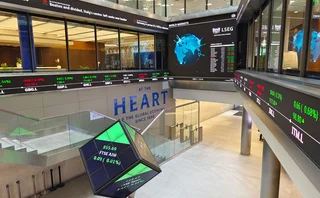
House of the year, Malaysia: CIMB
Asia Risk Awards 2020

By maintaining strong trading discipline and close ties with authorities, CIMB Malaysia has remained sure-footed through the market upheaval of early 2020 and, following a successful 2019, is well ahead of the market this year.
“It has been a very unusual year, which presented us with a number of challenges, but we weathered that particular storm very well,” says Chu Kok Wei, group head of treasury and markets for CIMB.
He says that “well-established and well-understood” risk appetite in the firm, as well as a deeply embedded culture of rigorous trading discipline, helped limit the impact of the Covid-19 fallout on the trading books.
“The market reaction to the pandemic took everyone by surprise, but our risk preparedness minimised the impact,” he says.
Having been heavily buffeted by the combinations of a US-China trade war and disruption to the oil markets in 2019, Malaysia’s gross domestic product grew at just 4.3%, its slowest rate in a decade.
Covid-19 struck at the same time that political upheaval was engulfing the country, following the resignation of prime minister Mahathir Mohammed. This created additional uncertainty and risks for investors and banks in the country.
“Businesses that survived during this period had no other resources or time to focus on anything else beyond getting through the movement control period,” Chu explains. “We saw a massive cutback in terms of risk appetite, and knock-on effects on the ringgit rates market, with swap requirements dropping drastically.”
In 2019, CIMB Group had reported operating income of 17.8 billion ringgit, 8.2% year-on-year growth largely thanks to non-interest income, which increased 12.9% based on improved trading and 6.7% loan growth.
In the foreign exchange space, CIMB managed to take advantage of the low volatility environment as it realised volatility was more depressed than the market was pricing in.
“We were pushing this trade where shorting volatility was a very profitable strategy for our sales team to market to our clients,” says Chu. “And this seemed to work well. Last year we saw an increase in our retail volumes as a result, which helped us jump from third to second spot in Bank Negara’s league table for FX options.”
Chu says this gave a boost to retail volumes in 2019, allowing the bank to jump from third to second spot in the central bank’s table for forex options.
Then, with increasing political and health concerns at the start of 2020, perspective on forex trading was reversed.
“There were jitters when news on Covid-19 emerged and volatility remained low. We managed to switch from short volatility strategy to go net long volatility, which worked well for us. We had potentially one of the best quarters ever – early 2020 – as a result,” says Chu.
Structured solutions
The bank’s activity in the cash bond space allowed it to make markets in interest rate derivatives, printing a record number of cross-currency asset swap deals in the notional amount of 608 million ringgits over the year compared with 40.6 million ringgits in the previous reporting period (April 2018 to March 2019).
Credit structuring excelled in core offerings, such as five-year ringgit-denominated credit linked notes (CLNs) for its high-net-worth retail investors. These products were tied to UK bank-holding companies at the subordinated level and allowed investors to get the contracted coupons until the maturity of the bond, regardless of whether a credit event happened.
“This helps to provide the investor with their promised returns for the entire duration of the investment, with the credit event settlement only taking place at maturity,” says Chu. “It also enables investors to gain exposure to these underlying names in MYR through a quanto conversion provided by CIMB.”
The bank also helped a local asset manager launch possibly the first leveraged fixed-income fund in Malaysia, which was targeted at high-net-worth investors, using a partially-funded structured total return swap, linked to fixed-income securities. It provided the fund with leveraged exposure to a portfolio of bonds on a non-recourse basis.
“Compared to conventional ways of getting leverage such as repo, this was a unique solution as the client could dynamically manage both the portfolio as well as overall level of leverage,” says Chu.
That control over leverage supported the clients’ desire for a convenient and simple structure. This reflected a breakthrough transaction for CIMB, purely as an outcome of the necessary trading for that client at the time, which was a pay-off for its efforts at developing several different structures over several years.
“The demand for enhanced fixed-income returns, which had been diminishing towards the end of last year, combined with our client who was aware of our capabilities, really meant the breakthrough was a question of finding the right solution in the right market opportunity,” says Chu.
In the commodities space, the increased interest in biodiesels led to a higher hedging activity from refineries and plantations, with an increase in palm oil volumes of 175% for 2019 versus 2018.
The gold price continued to rise, with a 12.6% increase in the third quarter of 2019. This led to a 162% increase in trading volumes across both paper gold accounts, and gold-based structured investments, by the end of the year.
Volatility in the market supported the bespoke use of commodity range bound Islamic negotiable instruments, which allow investors get returns based on performance of an underlying reference commodity. Taking a range bound view for a given commodity is most interesting for investors with potential upside value generated by market volatility.
The bank’s provision of Islamic products after “a long hiatus” began with enthusiasm as it saw a lack of investible assets in the Islamic space.
“Year on year, we have managed to increase sales significantly mainly thanks to the understanding and strong support of our salesforce. It also helps that commodity volatility was high during this period,” says Chu.
Collectively, the bank has proven itself capable in Malaysia of handling both low vol and very high vol situations through strong risk discipline, product development and, crucially, an understanding of client needs.
Only users who have a paid subscription or are part of a corporate subscription are able to print or copy content.
To access these options, along with all other subscription benefits, please contact info@risk.net or view our subscription options here: http://subscriptions.risk.net/subscribe
You are currently unable to print this content. Please contact info@risk.net to find out more.
You are currently unable to copy this content. Please contact info@risk.net to find out more.
Copyright Infopro Digital Limited. All rights reserved.
As outlined in our terms and conditions, https://www.infopro-digital.com/terms-and-conditions/subscriptions/ (point 2.4), printing is limited to a single copy.
If you would like to purchase additional rights please email info@risk.net
Copyright Infopro Digital Limited. All rights reserved.
You may share this content using our article tools. As outlined in our terms and conditions, https://www.infopro-digital.com/terms-and-conditions/subscriptions/ (clause 2.4), an Authorised User may only make one copy of the materials for their own personal use. You must also comply with the restrictions in clause 2.5.
If you would like to purchase additional rights please email info@risk.net
More on Awards
Clearing house of the year: LCH
Risk Awards 2025: LCH outshines rivals in its commitment to innovation and co-operation with clearing members
Best use of machine learning/AI: CompatibL
CompatibL’s groundbreaking use of LLMs for automated trade entry earned the Best use of machine learning/AI award at the 2025 Risk Markets Technology Awards, redefining speed and reliability in what-if analytics
Markets Technology Awards 2025 winners’ review
Vendors jockeying for position in this year’s MTAs, as banks and regulators take aim at counterparty blind spots
Equity derivatives house of the year: Bank of America
Risk Awards 2025: Bank gains plaudits – and profits – with enhanced product range, including new variants of short-vol structures and equity dispersion
Law firm of the year: Linklaters
Risk Awards 2025: Law firm’s work helped buttress markets for credit derivatives, clearing and digital assets
Derivatives house of the year: UBS
Risk Awards 2025: Mega-merger expected to add $1 billion to markets revenues, via 30 integration projects
Interest rate derivatives house of the year: JP Morgan
Risk Awards 2025: Steepener hedges and Spire novations helped clients navigate shifting rates regime
Currency derivatives house of the year: UBS
Risk Awards 2025: Access to wealth management client base helped Swiss bank to recycle volatility and provide accurate pricing for a range of FX structures







